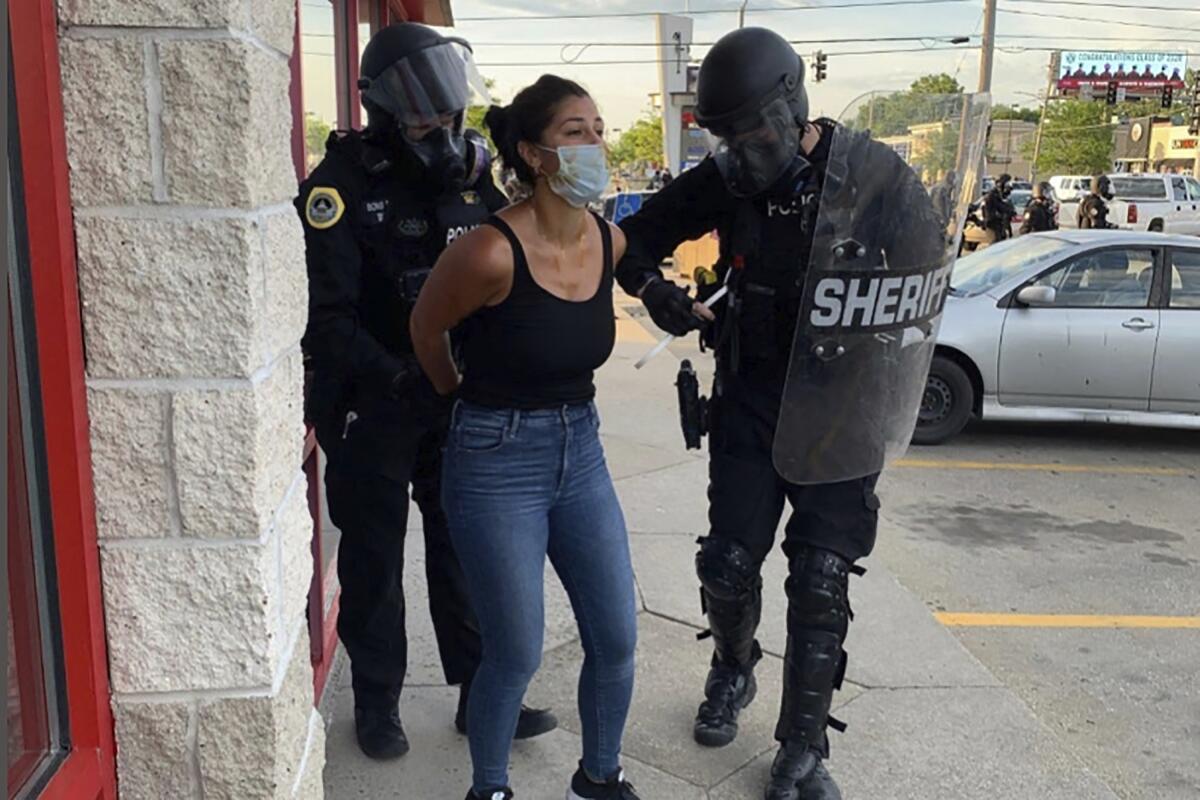Protect reporters at protest scenes

- Share via
Andrea Sahouri was acquitted of two misdemeanor charges Wednesday, and that’s good, but the Des Moines Register reporter never should have been brought to trial in the first place. Police arrested Sahouri over failure to disperse and interference with official acts on May 31 as she covered a Black Lives Matter protest following the death of George Floyd days earlier. As a reporter for a daily metropolitan newspaper, she believed she had a duty to stay on the scene to report events that were central to the city where she worked and, indeed, to the nation and the world.
Sahouri displayed her media credentials but was arrested anyway, as were more than 100 other journalists who covered racial justice protests last year. That’s one of the hazards and forms of intimidation reporters face for doing their work, although actual criminal prosecutions are rare — and, when they happen, irresponsible and outrageous. Many reporters who were not arrested at the protests were pepper-sprayed and shot with rubber and foam projectiles. Some were no doubt simply caught in the line of fire. But some believe police targeted them precisely for being reporters.
Things might have gone differently in Des Moines if Iowa had a law that specifically allows duly authorized journalists to do their work amid civil disturbances. It doesn’t. Neither does California, and Gov. Gavin Newsom vetoed a bill last year that was meant to grant reporters here those protections.
Now there’s a new version of the California legislation. Senate Bill 98, written by Sen. Mike McGuire (D-Healdsburg) and approved by the Senate Public Safety Committee on Tuesday, would prohibit the arrest or intentional police assault or obstruction of duly authorized reporters who stay on the scene after police close areas to the public, for example after ordering protesters to disperse. A reporter who is arrested anyway would be able to appeal to a supervisory officer.
It’s all good as far as it goes, and the bill deserves support. But there are limits to how well it can actually work, and that’s because of the term “duly authorized.” What does that mean? May only employees of legacy news organizations stay on scene after an order to disperse, or anyone with a smartphone and a blog? And authorized by whom? Do we cede to police or other government agencies the power to determine who is an authentic journalist, and to grant or withhold press credentials?
The questions touch on an age-old and unresolved (and perhaps unresolvable) dispute over what journalists are and whether their 1st Amendment protections are the same as, or greater than, anyone else’s.
One view has reporters at protest scenes as something akin to medics or clergy in times of war, clearly designated as noncombatants, exempt by law from police orders and entitled to be on hand to do the vital work of recording events. Many journalists see themselves in this special role, and it is their reporting from dangerous scenes that provides the public with essential information that otherwise would be solely under the control of police.
But that special status necessarily involves being granted permission, either by a licensing agency or an officer at the scene, to distinguish the “authorized” reporter from, say, a person writing an article for a Proud Boys blog.
In fact, Newsom vetoed the previous bill precisely because he believed it could have been exploited by “white nationalists, extreme anarchists or other fringe groups with an online presence.” The nightmare scenario is a Jan. 6-like invasion in which people storming the Capitol tell police they can’t be touched because they’re writing an account of the incident for a website. As it happened, credentialed reporters were detained at the real Capitol attack.
A different view of journalists makes them citizens exercising their 1st Amendment rights without special privileges, and when they are ordered to disperse, they disperse — or else they risk getting arrested, shot or tear-gassed along with everyone else. That model eliminates governmental or police power over who is or is not a “duly authorized” journalist. But it also gives police the ability to clear scenes of any journalists (along with protesters) who could document events on the public’s behalf.
No law can solve this dilemma, not even SB 98. Journalists need access and independence but can never get both, simultaneously, in sufficient measure. So reporting at police scenes is inherently hazardous. That’s what makes reporters like Sahouri, L.A. Times journalists including Molly Hennessy-Fiske and Carolyn Cole and hundreds of others across the country heroic for doing their risky work.
It is tempting to admonish police to simply not be jerks when they encounter reporters, and indeed that applies to the unconscionable Sept. 12 arrest of KPCC reporter Josie Huang by Los Angeles County sheriff’s deputies. There wasn’t even an order to disperse in effect when deputies tackled Huang, ignoring her shouts that she was a radio journalist.
Police might argue the same about protesters and perhaps a few reporters, but in the absence of a law to compel people not to be jerks, SB 98 may be the next best thing.
There remain serious questions about how police treated everyone at protests last year, not just reporters. The solution may have less to do with police treatment of reporters than it does with police treatment of everyone they protect and serve.
More to Read
A cure for the common opinion
Get thought-provoking perspectives with our weekly newsletter.
You may occasionally receive promotional content from the Los Angeles Times.









